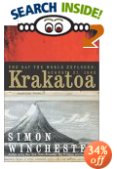|
When I heard of the book, I wanted to read about the disaster that
until 2003 killed more people than any in recorded history. The tale
was brought to my attention by my son-in-law whose morning coffee drinkers
discussed it because of the recent earthquake and resulting tsunamie
in Sumatra. Curious that the December disaster took place on the opposite
end of the same island over a hundred years ago. Not exactly the same
island. The volcano that exploded in 1883 was not on Sumatra. It was
a separate island and when the top blew off, the remainder of the island
sunk under the sea.
But let's get back to the book. How could it take over 600 pages to
describe the disaster? True there are more than 600 pages of print about
Mount St. Helen's with a Volanic Explosive Index under 6.5 that doesn't
make the top five list, and those pages repeat the description many
times over. KRAKATOA is written by a Brit - well why not? The technology
of the day even the mechanics' manufacture was dominated by that scientific
minded country - and Winchester does an overwhelming job of bringing
out not only the physical side of the disaster but development of industry,
geology, social, and pyscology before, during, and after the event.
Back in the 1940's I didn't get much science from my teachers whose
love and training was in football or politics, although they could have
connected somehow if they had the desire to do so because the developing
sciences were in the news even then, although not fully understood or
widely accepted. Winchester explains his fascination with the mountain
therefore his obsession with the content of the book: "It is a
volcano that seems to me to possess a wonderfully seductive combination
of qualities, being beautiful and dangerous, unpredictable and unforgettable."
Winchester puts a lot of relative science in those pages. The story
line is one that details the author's discoveries of connections to
the disciplines that shape our present understanding and awe of natural
forces. There is history of the exploitation of world resources in areas
dictated by the Pope in the 1500's and the resulting fortunes in lumber,
silk, and spices. Advances in cartigraphy are noted which aided the
rise of adventurous explorers and the fall of empires.
You have to read it to believe it. Little explanations are inserted
in precious sentences to clarify the fact - as with the Explosivity
Index. "This index, which was first created at the Smithsonian
Institution in Washington, is based on two features:....." He fills
in the background that may or may not be of interest to you but is relevant
to understanding the data it records.
The copy my library bought was in large print, making it a delight
to pick up for a few minutes any time I fancied - readable in poor light
with poor eyesight.
 |
KRAKATOA,
The Day the World Exploded
August 27, 1883
by
Simon Winchester
Thorndike Press,
Waterville, Maine
ISBN 0-7862-5729-6
|
Consider novels by Naomi Sherer available on Amazon


Coming Soon: Beyond Namche, The Open Door, Wildly in the Rockies
|


